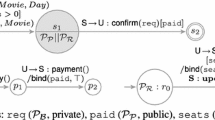Abstract
We show how to translate interaction protocols in AUML to equivalent Petri net specifications. A novelty of our approach is that the Petri nets are modular, clearly separating the protocol from the interaction behaviour of agents induced by their participation in the protocol, yet compositional. Our model can serve at least two purposes in multiagent systems engineering: firstly, specification and verification, and secondly, as a basis for synthesising skeleton code of interacting agents from specifications in the spirit of interaction-oriented programming.
Access this chapter
Tax calculation will be finalised at checkout
Purchases are for personal use only
Preview
Unable to display preview. Download preview PDF.
Similar content being viewed by others
References
W. v. Aalst. Structural characterizations of sound workflow nets. Technical report, Computing Science Reports 96/23, Eindhoven University of Technology, Eindhoven, 1996.
W. v. Aalst. The application of Petri nets to workflow management. The Journal of Circuits, Systems and Computers, 8(1):21–66, 1998.
W. v. Aalst. Interorganizational work.ows: An approach based on message sequence charts and Petri nets. Systems Analysis—Modelling—Simulation, 34(3):335–67, 1999.
W. v. Aalst and T. Basten. Inheritance of workflows: an approach to tackling problems related to change. Technical report, Computing Science Reports 99/06, Eindhoven University of Technology, Eindhoven, 1999.
B. Bauer, J.P. Müller, and J. Odell. Agent UML: A formalism for specifying multiagent interaction. In P. Ciancarini and M. Wooldridge, editors, Agent-Oriented Software Engineering, pages 91–103. Springer-Verlay, Berlin, 2001.
S. Chachkov and D. Buchs. From formal specifications to ready-to-use software components: The concurrent object oriented petri net approach. In Proceedings of the 2nd International Conference on Application of Concurrency to System Design (ACSD’01), pages 99–110, June 2001.
R. Cost, Y. Chen, T. Finin, Y. Labrou, and Y. Peng. Modeling agent conversations with colored petri nets. In Proc. 9th Int’l Joint Conference on Artificial Intelligence (IJCAI’99), 1999.
J. Desel and J. Esparza. Free Choice Petri Nets. Cambridge University Press, 1995.
J.M. Fernandes and O. Belo. Modeling multi-agent systems activities through colored Petri nets: An industrial production system case study. In 16th IASTED Int’l Conference on Applied Informatics (AI’98), pages 17–20, 1998.
N. Hameurlain. Formal semantics for behavioural substitutability of agent components: Application to interaction protocols. In 2nd Int’l Workshop of Central and Eastern Europe on Multi-Agent Systems (CEEMAS’01), pages 131–40, 2002.
S. Ling and S. Loke. Advanced petri nets for modelling mobile agent enabled interorganizational workflow. In Proc. 9th Int’l Conference on Engineering of Computer-Based Systems (ECBS2002), pages 245–52, 2002.
H. Mazouzi, A. El Fallah-Seghrouchni, and S. Haddad. Open protocol design for complex interactions in multiagent systems. In 1st Int’l Joint Conference on Autonomous Agents and Multi-Agent Systems (AAMAS’02), pages 517–25, 2002.
D. Moldt and F. Wienberg. Multi-agent-systems based on coloured Petri nets. In 18th Int’l Conference on Application and Theory of Petri Nets 1997, pages 82–101, 1997.
T. Murata. Petri nets: Properties, analysis and applications. Proceedings of the IEEE, 77(4):541–80, April 1989.
D. Poutakidis, L. Padgham, and M. Winikoff. Debugging multi-agent systems using design artifacts: The case of interaction protocols. In Proc. 1st International Joint Conference on Autonomous Agents and Multi-Agent Systems (AAMAS 2002), 2002.
M. Singh. Synthesizing coordination requirements for heterogeneous autonomous agents. Autonomous Agents and Multi-Agent Systems, 3(2):107–132, June 2000.
H. Xu and S.M. Shatz. A framework for modeling agent-oriented software. In 21st Int’l Conference on Distributed Computing Systems (ICDCS-21), pages 57–64, 2001.
Author information
Authors and Affiliations
Editor information
Editors and Affiliations
Rights and permissions
Copyright information
© 2003 Springer-Verlag Berlin Heidelberg
About this paper
Cite this paper
Ling, S., Loke, S.W. (2003). MIP-Nets: A Compositional Model of Multiagent Interaction. In: Mařík, V., Pěchouček, M., Müller, J. (eds) Multi-Agent Systems and Applications III. CEEMAS 2003. Lecture Notes in Computer Science(), vol 2691. Springer, Berlin, Heidelberg. https://doi.org/10.1007/3-540-45023-8_8
Download citation
DOI: https://doi.org/10.1007/3-540-45023-8_8
Published:
Publisher Name: Springer, Berlin, Heidelberg
Print ISBN: 978-3-540-40450-7
Online ISBN: 978-3-540-45023-8
eBook Packages: Springer Book Archive





